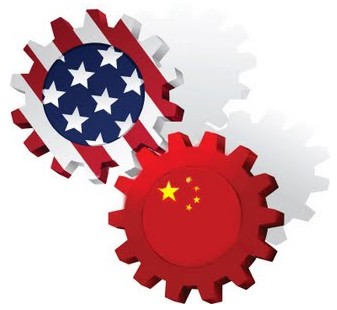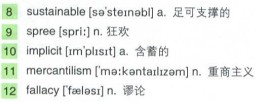中美贸易新拐点 The Turning Point of China-U.S. Trade
——诺贝尔经济学奖得主保罗·克鲁格曼上海交大演讲
美式发音 适合泛听
 2009年5月12日,美国当代最具影响力的经济大师、2008年诺贝尔经济学奖获奖者保罗·克鲁格曼(Paul Krugman)在上海交通大学,展开了一场题为“新格局下的中美经济未来”的经济演讲。
2009年5月12日,美国当代最具影响力的经济大师、2008年诺贝尔经济学奖获奖者保罗·克鲁格曼(Paul Krugman)在上海交通大学,展开了一场题为“新格局下的中美经济未来”的经济演讲。
上一期我们收录了这位经济学鬼才对现今全球经济前景的新一轮预测,这期我们关注的是中美贸易关系在这次全球经济危机出现后的变化。2010年1月6日,美国商务部表示,将对从中国进口的价值超过3亿美元的钢丝层板初步征收43%至289%的反倾销关税。这是2010年美国政府对华贸易限制的第一项裁决。然后是美国白羽肉鸡、中国礼盒及丝带……中美贸易制裁与反制裁之战轮番上演。
What we saw in the buildup to this crisis was a very extraordinary period of international imbalances. The picture that you want to look at is probably this one. This shows 1)current account imbalances in four major regions of the world. One of them—the purple lines pointing down, showing negative—is, of course, the United States, which became a very large 2)deficit country in the course of this…the run up to the crisis.3)Offsetting, matching the U.S. deficits were surpluses in three principal regions. One NIEs, that’s the Newly Industrialized Economies, that are already at advanced country levels of income; that means Taiwan, South Korea, Hong Kong, Singapore. They all began running 4)substantial surpluses after the financial crisis of the late 1990’s, largely as a 5)precautionary measure, but they were fairly modest. The Middle East—that’s obvious, that’s the oil-rich countries. They were running large surpluses. Those have gone away, but I think they’ll come back.
我们看到在这个危机的酝酿过程中,国际收支不平衡很严重。大家想有一个直观的概念可看看这张图。这张图展示的是世界四大片区中国际收支经常项目不平衡的状况,其中的一个区域——显示走下坡的紫色曲线,表示逆差——显然是美国。在这个过程……在这个危机到来前,美国成了一个赤字大国。与美国赤字相抵消、相对应的是三大片区的贸易顺差。一是指新兴的工业化经济体(NIE),指的是已经达到发达国家收入水平的(亚洲)地区,包括台湾、韩国、香港、新加坡。上世纪九十年代后期的金融危机过后,他们均开始有充裕的贸易盈余,这主要是作为一种防御措施,但是他们的盈余比较适中。这是中东地区,很显然,石油富足的国度,他们有庞大的盈余,虽然现在少了,但我认为将来还会卷土重来。
And the big part is developing Asia, which means Vietnam, means some of the other parts of Asia. But mostly it means you. Mostly it means China.
较大的一块盈余来自发展中的亚洲国家,就是指越南,和一些其他的亚洲国家,但是其中最主要指的就是在座的各位,主要指的就是“中国”。
China began running enormous surpluses—current account surpluses of 10% or more of 6)GDP. And for quite a while it was a comfortable7)arrangement for everybody. The United States got cheap money, which we could use to finance construction of houses and also high levels of consumption. China got a very large export market, was able to rely upon export-driven growth during this period; very comfortable arrangement—a little strange if you thought about it. I wrote, back in 2005, that the U.S. economy had become a place in which people made a living by selling each other houses, which they paid for with money they borrowed from China. So it was not exactly a 8)sustainable arrangement, but it was an arrangement that, for a while, seemed to work for everyone.
中国开始有大量的贸易盈余,国际收支经常项目盈余占了GDP的10%,甚至更多。很长一段时间来说,大家都很乐见这样的贸易模式。美国有更便宜廉价的资金,我们有更多的钱造房子、保持高度的消费热;中国有了一个庞大的出口市场,在这时期可以发展出口驱动型经济。皆大欢喜,但是你细想一想就觉得有点不对劲。早在2005年我就写过一篇文章,指出美国的经济已经成为人们相互靠卖房子来过活的社会,买房子的钱都是从中国借来的。所以这不是可持续的交易模式,但是有一阵子,这方法似乎确实可行。
It’s not going to work, looking forward. We’re not going to return to the days of 2006 / 2007, when all of this worked smoothly. The United States was on a great borrowing 9)spree, not just looking at nationally, but ’specially if you look at households. The arrangement we had between the United States and China, the 10)implicit arrangement, and we can’t do that any more; no more of that kind of borrowing. In the United States, consumers have begun to save again; the savings rate has risen from zero to four. My guess is it will keep rising ’til around eight. We always say that free international trade is good for everyone. We always say that a country that runs a trade surplus is actually helping other countries, because it’s supplying them with cheap goods. But in a world that is persistently under-employed, unfortunately, this is not true. Countries that are running trade surpluses are creating a problem for the deficit countries. This is a world in which surpluses are a “begger-thy-neighbor” policy, a policy that does reduce demand and employment in other countries. This is a world in which 11)mercantilism, which is ordinarily a great 12)fallacy, is not so much of a fallacy, and so it’s a world in which this kind of surplus becomes a real irritant.
但是展望未来,这样肯定难以为继。我们再也不可能回到2006、2007年危机爆发之前的状态,当时这种模式的运作一切正常。美国当时疯狂地借钱,不仅是在国家层面,家庭尤其如此。中美之间的贸易模式,心照不宣的交易,不能再这样下去了,不能继续这样借贷了。在美国,消费者又开始存钱了,储蓄率从0攀升到4,我觉得它会继续攀升到8左右。我们总是说国际自由贸易利及众人。我们总是说贸易盈余的国家实际上是在帮助其他国家的,因为它是向他们提供便宜的产品。但是如今在这个失业率高居不下的世界,遗憾的是刚才所说的不再属实。贸易盈余不断增长的国家正在给赤字国添麻烦。现今世界,贸易盈余犹如一种“以邻为壑”的政策,使得他国的本土产品需求和就业率下降。重商主义往往被认为是一种谬论,但从现今状况看来,也变得不那么荒谬了,因此现今世界这样的贸易盈余成了让其他国家非常气恼的地方。
I don’t know how this is going to play out, but I do know that if there is not a resolution, there’s going to be extreme tension over China’s surpluses. The period of sustained surpluses is no longer going to have the kind of tolerance from the rest of the world. Now, how is that going to work? That doesn’t mean that China has to suffer terrible consequences. It means that China has to reorient its economy towards domestic demand. The era of export-led growth, the era of growth fed by gigantic trade surpluses, cannot last in the world we are now entering.
我不知道这将如何收场,但我能肯定的是,如果没有一个很好的解决方法,中国的盈余将会带来很大的贸易紧张局面,其他国家无法继续容忍这种持续的贸易盈余。如今应该怎样解决问题?这并非意味着中国要承担严重的后果,而是指中国该把其经济重心调到内需上。出口驱动型经济增长时期、由大幅的贸易盈余所支持的经济增长时期在未来的日子将难以持续。 翻译:晓敏



